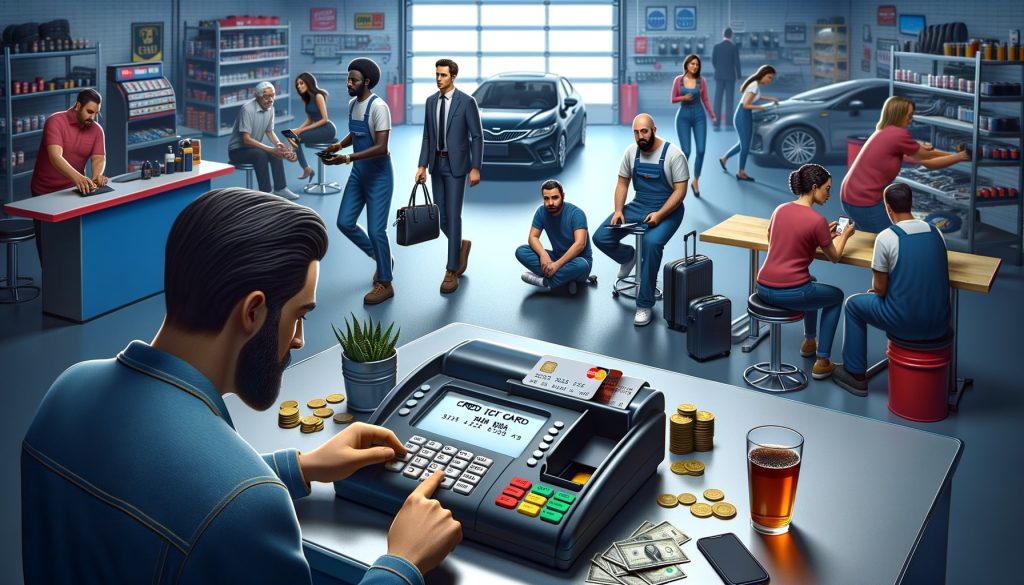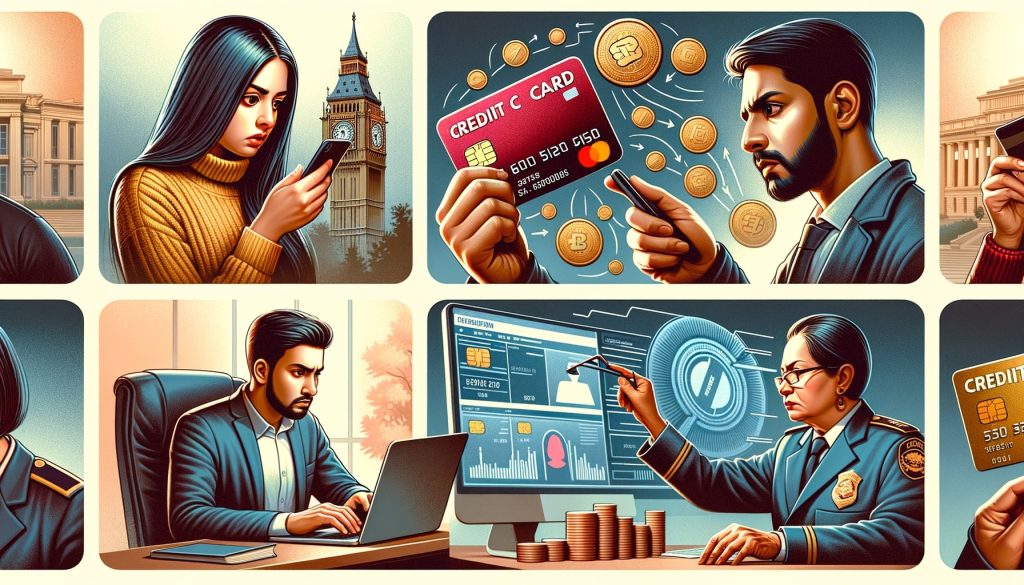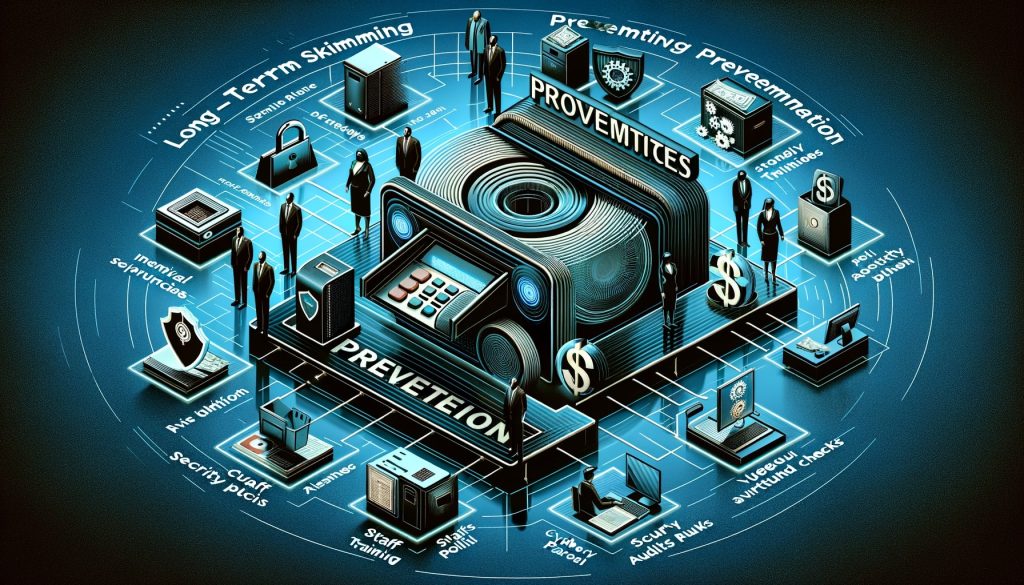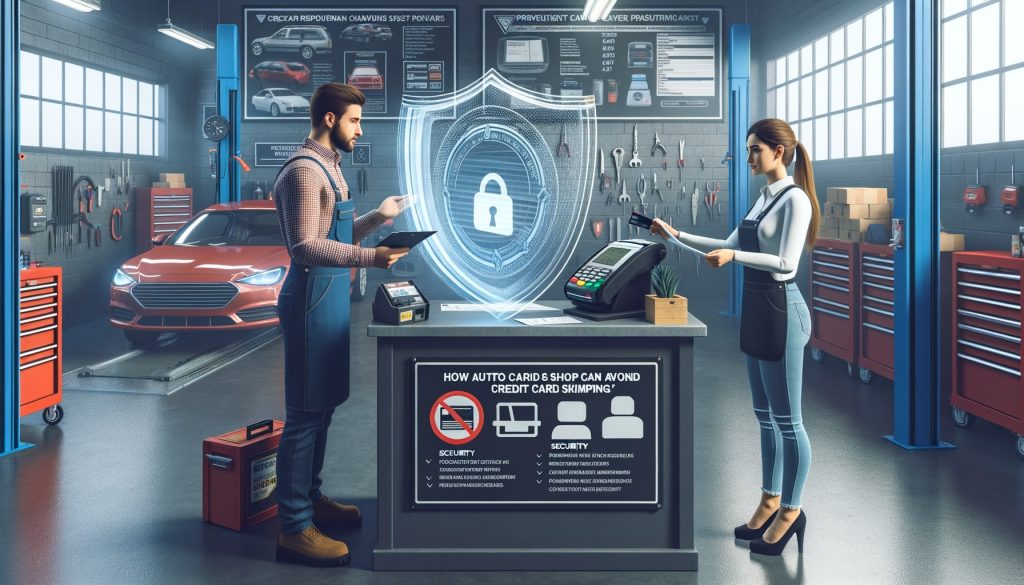Credit card skimming is a growing threat for businesses, including auto repair shops. Criminals can use skimming devices to steal card information, leading to financial losses and damaged reputations for businesses. For auto repair shops, where customers frequently use credit cards for large transactions, skimming poses a significant risk. Implementing preventative measures to protect your business from credit card skimming is essential to safeguarding customer trust and minimizing potential losses.
This comprehensive guide explores how auto repair shops can avoid credit card skimming, offering practical tips and strategies for preventing this type of fraud. We’ll also discuss how credit card skimming works, the signs to look out for, and the best practices to keep your payment processing systems secure.
Table of Contents
ToggleWhat Is Credit Card Skimming?

Credit card skimming is a form of payment fraud where criminals use a small device, known as a skimmer, to illegally collect information from a customer’s credit card. Skimmers are typically installed on card readers, such as those found at gas stations, ATMs, or point-of-sale (POS) systems in retail and service businesses like auto repair shops.
When a customer swipes or inserts their card into a compromised card reader, the skimmer captures the card’s data, including the card number, expiration date, and sometimes even the cardholder’s name and PIN. This information is then used to make fraudulent transactions or sell the stolen data on the black market.
How Skimming Devices Work
Skimming devices are usually small and designed to blend in with legitimate card readers, making them difficult to detect. There are two common types of skimming devices:
- Physical Skimmers: These devices are attached to card readers, such as gas station pumps or POS systems, to capture card data when the card is swiped or inserted.
- Wireless Skimmers: These use Bluetooth or other wireless technology to transmit card data to a nearby device without the need for physical removal of the skimmer.
The Impact of Credit Card Skimming on Auto Repair Shops
For auto repair shops, the consequences of credit card skimming can be severe. Businesses face chargebacks, lost revenue, fines, and potential damage to their reputation. In addition, customers who fall victim to skimming at your business may lose trust in your security measures and take their business elsewhere.
Common Ways Credit Card Skimming Happens in Auto Repair Shops

Credit card skimming can occur in various ways, especially in businesses like auto repair shops where payment transactions are frequent and high in value. Some of the common methods include:
1. Compromised Point-of-Sale Systems
Skimmers can be placed on or inside POS systems, capturing card data when customers make payments. Criminals may install these devices during off-hours or by posing as repair technicians to gain access to the systems.
2. External Card Readers
Many auto repair shops have external card readers for after-hours payments or at self-service kiosks. These devices are particularly vulnerable to skimming attacks since they are less frequently monitored, giving criminals more opportunities to install skimmers.
3. Gas Pump Skimming
Auto repair shops that offer fuel services are at an even higher risk of credit card skimming. Gas pumps are common targets for skimmers, as they often use outdated technology and are left unattended for long periods, making it easy for criminals to install skimming devices.
4. Employee Involvement
In some cases, skimming can be carried out by dishonest employees who attach skimmers to POS systems or use handheld skimmers to capture card information during transactions.
How Auto Repair Shops Can Prevent Credit Card Skimming
Preventing credit card skimming requires a combination of technology, employee training, and regular system monitoring. Below are several strategies that auto repair shops can implement to protect themselves and their customers from skimming attacks.
1. Invest in EMV Chip Readers
One of the most effective ways to prevent credit card skimming is to upgrade your POS systems to accept EMV chip cards. EMV (Europay, MasterCard, and Visa) chip technology encrypts the cardholder’s data, making it much more difficult for skimmers to capture usable information.
Why EMV Technology Is Safer
Unlike magnetic stripe cards, which store static data that can easily be copied by skimmers, EMV chip cards generate a unique transaction code each time the card is used. This means that even if a criminal manages to intercept the data, they cannot use it for fraudulent transactions because the transaction code is only valid for that specific transaction.
How to Implement EMV Technology
To protect your auto repair shop from skimming, invest in POS terminals that support EMV chip card processing. Train your staff to encourage customers to use chip cards whenever possible, and if your shop accepts contactless payments, ensure your systems are equipped with Near Field Communication (NFC) technology for added security.
2. Regularly Inspect Payment Terminals
Conduct routine inspections of all payment terminals, including those in less frequented areas such as self-service kiosks and external card readers. Look for any signs of tampering or unfamiliar devices attached to the card reader. Criminals often place skimming devices over legitimate card readers, so pay attention to any parts that seem out of place, loose, or bulky.
What to Look for During Inspections
- Card readers that appear bulkier than usual
- Loose or wobbly components on the card reader or keypad
- Unfamiliar devices attached to or near the card reader
- Discolored or misaligned parts on the payment terminal
By regularly inspecting your payment terminals, you can catch skimming devices before they compromise your customers’ data.
3. Monitor Surveillance Footage
Installing surveillance cameras near payment terminals can help deter criminals from attempting to install skimming devices. Additionally, monitoring footage can provide valuable evidence if an incident occurs.
Tips for Effective Surveillance
- Position cameras to clearly capture all payment terminal activity.
- Ensure that the cameras are tamper-resistant and have adequate lighting.
- Regularly review footage, especially during off-hours when the risk of skimming device installation is higher.
- Train your employees to report any suspicious activity near payment terminals.
4. Use End-to-End Encryption (E2EE)
End-to-End Encryption (E2EE) ensures that sensitive card data is encrypted as soon as it is entered into the payment terminal and remains encrypted until it reaches the payment processor. This prevents skimmers from intercepting card data at any point during the transaction process.
Implementing E2EE at Your Auto Repair Shop
Many modern POS systems offer E2EE as part of their security features. When choosing a payment processor, look for one that provides encrypted payment solutions and integrates E2EE into their terminals. This will help safeguard both card-present and card-not-present transactions.
5. Train Your Employees
Your employees are your first line of defense against credit card skimming. Properly training your staff to recognize and prevent skimming attempts can significantly reduce the risk of fraud.
Key Areas of Employee Training
- Identifying Suspicious Devices: Teach employees how to spot skimmers and the signs of tampered payment terminals.
- Handling Transactions Safely: Encourage employees to use EMV chip readers whenever possible and to avoid manual card entry, which can increase the risk of fraud.
- Responding to Suspicious Behavior: Train staff to be aware of suspicious individuals loitering near payment terminals or attempting to interfere with the equipment.
- Reporting Incidents: Ensure that employees know the proper protocol for reporting suspected skimming devices or fraudulent activity to management and law enforcement.
6. Use Secure Payment Gateways for Online Transactions
Many auto repair shops offer customers the option to pay invoices online or prepay for services. To prevent skimming and other forms of fraud during online transactions, make sure your payment gateway is secure.
Features to Look for in a Secure Payment Gateway
- SSL Encryption: Ensure that the payment gateway uses Secure Socket Layer (SSL) encryption to protect cardholder data during transmission.
- PCI Compliance: Verify that the payment gateway is compliant with the Payment Card Industry Data Security Standard (PCI DSS), which outlines security measures for handling credit card information.
- Tokenization: Use a payment gateway that supports tokenization, which replaces sensitive card information with a unique token that can’t be reused or compromised by fraudsters.
7. Update Software and Systems Regularly
Outdated POS systems and software are more vulnerable to skimming attacks. Criminals often exploit security gaps in older systems to install skimming devices or hack into payment systems.
Best Practices for System Updates
- Regularly update your POS software to ensure it includes the latest security patches and enhancements.
- Upgrade any outdated hardware, such as old card readers, that may not support newer security features like EMV or NFC technology.
- Work with your payment processor to ensure your payment systems are PCI compliant and follow best practices for data security.
Responding to Credit Card Skimming Incidents

Despite your best efforts to prevent credit card skimming, there’s always a chance that an incident may occur. Knowing how to respond quickly and effectively can mitigate the damage and protect your business and customers.
1. Identify the Compromised Terminal
If you suspect that one of your payment terminals has been compromised by a skimmer, take immediate action to remove the device and stop further fraud from occurring.
Steps to Take
- Shut down the affected terminal and remove it from service.
- Inspect the device to identify the skimmer and take photos for documentation.
- Notify your payment processor and report the incident to local law enforcement.
2. Notify Affected Customers
If customer data has been compromised due to a skimming incident, it’s essential to notify your customers promptly. Provide them with information on how to check for fraudulent activity on their accounts and encourage them to report any unauthorized transactions to their card issuer. Transparency and quick communication can help maintain customer trust, even in the event of a data breach.
Key Steps in Customer Notification:
- Provide a Clear Explanation: Inform customers of what happened, how their data might have been compromised, and what steps you’re taking to resolve the issue.
- Offer Assistance: Encourage affected customers to monitor their accounts and provide guidance on how to report fraudulent transactions to their card issuer.
- Ensure Transparency: Be upfront about the situation, but reassure customers that you’re taking necessary steps to prevent future occurrences.
3. Conduct a Full Security Audit
After identifying and addressing a skimming incident, it’s essential to conduct a full security audit of your payment systems and business processes. This can help identify other potential vulnerabilities and ensure that your systems are fully secure moving forward.
Components of a Security Audit:
- Review All Payment Terminals: Inspect all payment terminals, both inside and outside the shop, for signs of tampering or skimming devices.
- Analyze Transaction History: Look for any patterns or suspicious transactions that may indicate other incidents of fraud.
- Upgrade Security Measures: Based on the findings of the audit, take steps to upgrade hardware, software, and employee training to address any vulnerabilities.
4. Work with Law Enforcement and Payment Processors
In the event of a skimming incident, you must report the crime to local law enforcement. They may be able to investigate further and potentially identify and apprehend the criminals responsible. Additionally, work closely with your payment processor to ensure that all compromised data is reported, and follow their guidelines for securing your systems and preventing future incidents.
Steps to Take:
- File a Police Report: Provide law enforcement with any relevant details, including surveillance footage, evidence of tampering, and customer reports of fraud.
- Cooperate with Your Payment Processor: Your payment processor can provide valuable insights and help you secure your systems against future attacks.
Best Practices for Long-Term Skimming Prevention

Preventing credit card skimming requires a long-term commitment to security. By implementing the following best practices, you can protect your auto repair shop from future skimming incidents and build a reputation as a secure and trustworthy business.
1. Stay Informed About New Threats
Fraudsters are continually evolving their methods to bypass security measures, so it’s important to stay up-to-date on the latest trends in credit card skimming. Subscribe to industry publications, attend security webinars, and consult with your payment processor regularly to stay informed about emerging threats.
2. Perform Routine Security Checks
Conduct regular security checks of all payment terminals, card readers, and other equipment. This should include both visual inspections for skimmers and software checks to ensure that all systems are running the latest security patches.
3. Use Strong Access Control Measures
Limit access to your payment terminals and sensitive areas of your business to authorized personnel only. Implement strong access control measures, such as PIN codes or keycards, to prevent unauthorized individuals from tampering with your equipment.
4. Consider Tokenization and Encryption Solutions
In addition to EMV and NFC technologies, tokenization and encryption are powerful tools for protecting cardholder data. Tokenization replaces sensitive card information with a unique identifier that cannot be reused, while encryption ensures that data remains protected throughout the transaction process. Work with your payment processor to implement these solutions for maximum security.
5. Educate Your Customers
While much of the responsibility for preventing skimming lies with the business, educating your customers can also help reduce the risk of fraud. Encourage customers to use chip-enabled cards or contactless payments, remind them to report suspicious activity, and inform them of the steps you’re taking to keep their data secure.
FAQs About Credit Card Skimming Prevention in Auto Repair Shops
1. What is credit card skimming?
Credit card skimming is a form of fraud where criminals use a device to steal card information from unsuspecting customers when they swipe or insert their cards into compromised payment terminals.
2. How can auto repair shops detect skimming devices?
Auto repair shops can detect skimming devices by regularly inspecting payment terminals for any signs of tampering, unfamiliar devices, or components that appear loose or bulky.
3. How does EMV technology prevent skimming?
EMV chip technology protects against skimming by generating a unique transaction code for each payment. Unlike magnetic stripe cards, which store static data, EMV cards make it difficult for fraudsters to use the stolen information.
4. What steps should I take if my auto repair shop experiences a skimming incident?
If your shop experiences a skimming incident, immediately shut down the affected terminal, report the incident to law enforcement and your payment processor, and notify affected customers. Conduct a full security audit to identify and fix any vulnerabilities.
5. Can online payments be affected by skimming?
No, skimming typically affects card-present transactions where the card is physically swiped or inserted into a reader. However, online transactions can be vulnerable to other forms of fraud, so it’s important to use secure payment gateways with encryption and tokenization.
Conclusion
Credit card skimming is a serious threat to auto repair shops, but with the right strategies in place, it can be effectively prevented. By investing in EMV chip technology, regularly inspecting payment terminals, training employees, and staying informed about emerging security threats, auto repair shops can significantly reduce their risk of falling victim to skimming attacks.
Additionally, working with secure payment processors and adopting technologies like encryption, tokenization, and NFC can further safeguard your business and customers. In the event of a skimming incident, knowing how to respond quickly and effectively will minimize damage and help maintain customer trust.
Taking a proactive approach to preventing credit card skimming not only protects your auto repair shop from financial losses but also demonstrates your commitment to security, which can help you build long-lasting relationships with your customers. By following the guidelines outlined in this article, you can ensure your shop is equipped to handle the ever-evolving threat of credit card fraud.
